

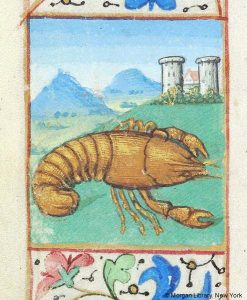
On June 21st we recognize Cancer, the astrological sign that Richard Hinckley Allen called the most “inconspicuous figure of the zodiac” (Allen, 107). Representing the sun at its highest point, Cancer is the zodiacal sign of the summer solstice. In ancient Egypt, the Cancer sign was imagined as a scarab beetle, and in Mesopotamia as a turtle or tortoise, both of which may have pushed the sun across the heavens. In Europe, traditionally, the constellation of Cancer was identified with the crab from Greek mythology that was crushed by the foot of Hercules and placed in the sky by Hera. Some have speculated that the characteristic sideways walk of hard-shelled crustaceans, whether crayfish or crab, could be symbolic of the backward shift in day-length after the arrival of the summer constellation in the Northern Hemisphere at the end of June, and Medieval people also believed those born under Cancer’s influence harnessed great, gripping power.
At the Index of Christian Art, the label “lobster-like” has been used to describe Cancerian crabs that are not at all “crab-like.” These crustaceans have elongated pincers, chunky claws, and a distinct tail, and they more closely resemble a lobster or a crayfish. The zoological treatise The Crustacea, published by Brill in 2004, states that, although crabs are the most frequent symbol of the Cancer sign, that the variety of shellfish that adorn horoscopes “can bring surprises” (Forest et al., 173). It is possible that while the symbol of Cancer may draw from a singular iconographic entity which included all shellfish, the idea of a distinct crab, including its spoken and written labels, could be historically transmutable. A definitive explanation for the choice of crustacean in horoscopes might be impossible, but there are some hints as to why “lobster-like” crabs were so pervasive in zodiacal art of the medieval period.
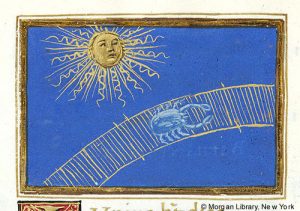
“Cancer,” “Crab,” & “Crayfish”
“Cancer” is an ancient word of Indo-European origin from a root meaning “to scratch.” Today Cancer is the scientific Latin genus name for “crab,” but in classical usage it described many species of shellfish. J.-Ö. Swahn notes in “The Cultural History of Crayfish” that in both Sanskrit and Greek the word for crab had the same meaning as crayfish, both animals having pincers. While the Latin word for Cancer, Carcinus, comes from the Greek karkinos, the English word “crab” has Germanic and Old English roots, and an Anglo-Saxon chronicle from about the year 1000 identified Cancer as crabba (Allen 107). In Old High German (800-1050), kerbiz meant simply “edible crustacean” and was also used to describe crayfish. The OED links the Middle High German (1050-1350) krebz to the Middle French (ca. 1400-1600) escrevisse, which in turn became écrevisse (crayfish).
The OED cites these words for crayfish, through much of their history, were general terms for all larger edible crustaceans. On “lobster,” OED notes some crayfish are called “fresh-water lobsters” and the term “lobster” is applied to several crustaceans of resemblance. Well into the seventeenth century, the word “cancer” and its translations were used as generic terms for all crabs and “lobster-like” creatures until Linnaeus established the species name Astacus Astacus for crayfish in his Systema Naturae of 1758 (interestingly, also with the synonym Cancer Astacus). The OED also noting that the 1656 translation of Comenius’ Latinae Linguae Janua Reserata, described the crayfish as a “shelled swimmer, with ten feet, and two claws: among which are huge Lobsters of three cubits; round Crabs; Craw-fish, little Lobsters.” So, etymologically speaking, crabs, crayfishes, and lobsters were mingled together from very early on.

Star Sign and Sustenance
In the Middle Ages, the zodiacal symbol of Cancer often appeared in the calendar pages of devotional books, or on adorned monumental sculpture of the Middle Ages. The Index records examples in these mediums (including examples on more than 200 manuscript pages) with the subject heading Zodiac Sign: Cancer. Generally, the depiction of the sign of Cancer as a crab is most prevalent in art from the Mediterranean and Western Europe, possibly due to the proximity to the sea, but the crayfish as a symbol for Cancer is not unusual, even in coastal regions. Crabs are saltwater decapods, creatures with ten feet or five pairs of legs. Crayfish are also decapods, but they thrive in freshwater lakes and rivers. Summer was the best season for fishing, and crayfish were easily trapped along the streams and creeks of rural Europe. The French and the English were the first to incorporate crayfish into their diet.
The Romans had viewed the crayfish as a scavenger animal, and they disliked the taste in their cuisine. Elevated from its lowly status as mere fodder in the classical era, crayfish came to be considered a delicacy in Western Europe from as early as the tenth century. In medicine, the sign ruled over the chest, stomach and ribs, and there are also several medieval pharmacological texts that note the medical properties of the crayfish, including the fact that “If you boil them in milk they cause a good sleep” (Swahn, “The Cultural History of Crayfish,” 247). We know that Europeans were using crayfish in their recipes and tinctures, so their distinctive form would have been a familiar one.
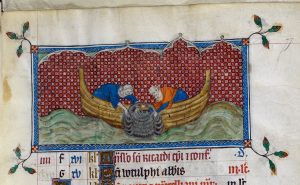
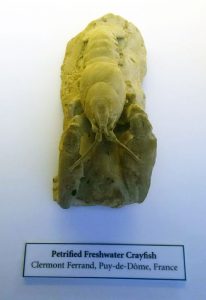
Sources
Allen, Richard Hinckley, Star-names and Their Meanings (New York, Leipzig: G.E. Stechert, 1899), 107-111.
Fischof, Iris, “The Twelve Signs,” in Written in the Stars: Art and Symbolism of the Zodiac (Jerusalem: Israel Museum, 2001), 111.
Forest, Jacques, J. C. von Vaupel Klein, and J. Chaigneau, The Crustacea: Treatise on zoology – anatomy, taxonomy, biology: Revised and updated from the Traité de zoologie (Leiden: Brill, 2004), 173.
Larkin, Deirdre, “Making Hay: The Zodiacal Sign of Cancer,” The Metropolitan Museum of Art Blog, June 5, 2009, http://blog.metmuseum.org/cloistersgardens/2009/06/05/making-hay/060509_bottom/
Swahn, J.-Ö, “The Cultural History of Crayfish,” Bulletin Français de la Pêche et de la Pisciculture 372-373 (2004): 243-251.
Oxford English Dictionary, s.v. “Cancer,” “Crab,” “Crayfish,” “Lobster,” accessed June 2016, http://www.oed.com/.
“Summer and Crayfish,” The Medieval Histories Blog, June 15, 2016, http://www.medievalhistories.com/summer-and-crayfish/.
The Index of Christian Art presents three images in honor of the 160,000 allied troops who landed on the fortified beaches of Normandy on 6 June 1944. The first, a detail of the Bayeux Embroidery portraying Duke William of Normandy sailing to England, evokes the seaborne operation that marked the beginning of the liberation of occupied Europe from Nazi control. The second, a sculpted personification of Fortitude holding a sword and shield from the west façade of Notre-Dame of Paris, speaks to the courage and resilience of the allied forces in the face of the enemy. The third, Ambrogio Lorenzetti’s languid depiction of Peace from the Allegory of Good Government fresco in the Palazzo Pubblico in Siena, alludes to the aftermath of the war, while also expressing hope for the resolution of current conflicts worldwide.
Mother’s Day has been celebrated annually in the United States on the second Sunday in May for over one hundred years. Following its declaration as an official holiday by the state of West Virginia, Woodrow Wilson issued a proclamation announcing the first national Mother’s Day on 9 May 1914.
Images of the Virgin and Child are among the most common depictions of motherhood from the Middle Ages. The Strahov Madonna of ca. 1340 captures the dynamism (or “squirminess”) typical of small children, while also communicating to beholders the special status of the figures through solemn expressions and meaningful gestures. The Child grasps his mother’s veil with his left hand and holds a goldfinch in his right hand, a pose adapted from the Virgin Kykkotissa, a highly venerated, miracle-working Byzantine icon thought to have been painted from life by Saint Luke. Portrayals of the Visitation present an earlier stage of motherhood.
A fifteenth-century French Book of Hours shows the pregnant Virgin gently cradling her swollen abdomen as she greets her cousin Elizabeth, pregnant with John the Baptist, who “leaped in her womb” (Luke 1:41). A thirteenth-century fresco of the birth of John the Baptist from Parma Baptistery captures yet another aspect of motherhood, depicting two midwives tending to Elizabeth as two others bathe her newborn infant.
The Index of Christian Art has 29 subject records for the Virgin Mary and Christ Child. John the Baptist: Birth appears in 104 records.
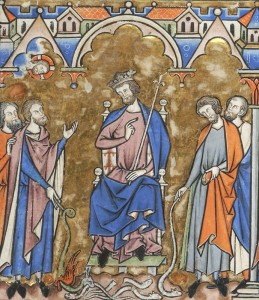
Detail of Moses: Miracle of Rod changed to Serpent. Old Testament Picture Book. French, c. 1250. Morgan Library, M.638, fol. 8r
Nine times Moses went to the Egyptian Pharaoh Ramses II to demand freedom for the Israelites in captivity, saying “Let my people go.” Each time Moses and his brother Aaron were sent a way, an episode classified by the Index as, Moses and Aaron: driven from Pharaoh’s Presence. Despite these increasingly tense exchanges, and then a marvelous act that changed Aaron’s rod into a serpent before the Pharaoh’s court (Moses: Miracle of Rod changed to Serpent), Ramses still refused to release the Israelites from slavery.
What followed was the foretold wrath of God enacted as ten crippling plagues on the Egyptians. In the first wave of calamities, there were plagues of blood, frogs, gnats, and lice that polluted the air and water. The second wave, brought plagues of flies, diseased livestock, and boils. Then came hail, locusts, and darkness that fell on Egypt for three days. The tenth and final plague, the “Plague of the Firstborn,” claimed the lives of the eldest children in all Egyptian families. The Index of Christian Art classifies the subjects of the Exodus plagues under the major figure of Moses:

Moses: Plagues of Flies, Frogs, Locusts, Hail and Pestilence. Stuttgart Psalter, c. 820-830. Stuttgart Landesbibliothek, Bibl.fol.23, fol. 93r. Photograph by Gabriel Millet.
(Exodus 9:6-7)
The final plague is described in several phases throughout the books of Exodus (11:4-8; 12:1-13, 21-23, 29-30). Moses first warns of its coming to the embattled Ramses, but his warning is dismissed.
Facing the impending deadly plague, Moses instructs the Israelites to make a sacrificial offering to God, and to use the blood of the animal – a male yearling – to mark the doorposts and lintels of their homes. Moses explains to them that marking their homes this way will spare their firstborn children from the “death angel,” saying he “will pass over the door.” (Exodus 12:23).
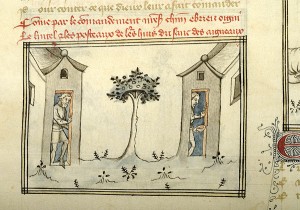
Moses: Plague of Firstborn. Two Israelites marking the doorposts and lintels of their homes with the blood of the sacrificial lamb. History Bible, Paris, c. 1390. Morgan Library, M.526, fol. 14v
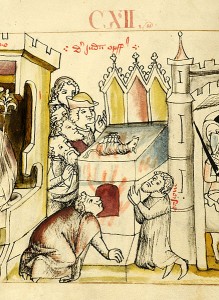
Detail of Moses: Passover. Israelites cooking the sacrificial lamb under the inscription “Die Juden Opffer.” Historien Bibel, Swabia, late 14c. Morgan Library, M.268, fol. 7v
Following this, the Israelites were delivered from bondage and departed from Egypt. The Exodus is remembered at the feast of Passover – the Hebrew feast of Pesach – with special instructions for preparing, eating, and storing traditional, often symbolic food. While Passover traditions have varied over time and from one region to another, it is generally a family holiday in which the meal is accompanied by readings, songs, and traditional rituals designed to remind the celebrants of the Exodus story and the hopes for a rebuilt Temple in Jerusalem. The order of the seder, or Passover meal, is set out in a book known as the Haggadah, which was sometimes richly illuminated in the Middle Ages, as shown here in the Sarajevo Haggadah, originating in Barcelona in the middle of the 14th century. Well-known related manuscripts to this Haggadah include the Rylands Haggadah and the Simeon Haggadah. The Index classifies subjects depicting the original Passover feast as Moses: Passover, Moses: Passover proclaimed, and Moses: Law, Feast of Passover and with a general heading for Scene: Passover.

Bitter herb or “maror” in the Sarajevo Haggadah. Barcelona, c. 1350. Sarajevo, National Museum of Bosnia and Herzegovina. Photograph Wikimedia Commons.
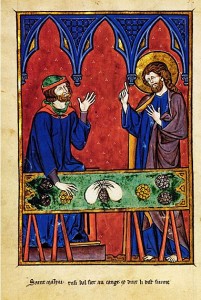
The middle of April strikes dread (or joy) in the hearts of millions of tax filers. Since 1955, April 15 has typically marked the end of the tax season in the continental US. This year, however, filers have received a three-day reprieve to accommodate Emancipation Day in Washington D.C, which is observed on the weekday closest to April 16 when it falls on a weekend.
Saint Matthew is among the best-known tax collectors in the history of Christian art. According to the gospel accounts, Jesus encountered Levi (Matthew’s name before his conversion) in the custom house of Capernaum on the northern shore of the Sea of Galilee. Jesus said to him, “Follow me,” and Matthew obeyed.
A remarkable depiction of Christ calling Matthew appears in the Picture Book of Madame Marie, a thirteenth–century French devotional manuscript now at the Bibliothèque nationale de France in Paris. The scene takes place beneath sharply-cusped arches and against a fiery background. Wearing a brilliant blue garment and purple cloak, Christ addresses Matthew, whose money table has been dramatically tilted to reveal neat piles of gold and silver coins. Thematically related is a fifth-century gold solidus of Pulcheria with the empress wearing an elaborate coiffure and lavish jewels, a macabre Dance of Death featuring a money-changer from a fifteenth century French Book of Hours, and a regal image of the Queen of Coins on a fifteenth-century Italian tarot card.
May the rocks in your field turn to gold!
“And when he was come into Jerusalem, the whole city was moved, saying: Who is this? And the people said: This is Jesus the prophet, from Nazareth of Galilee.” (Matthew 21:10-11)
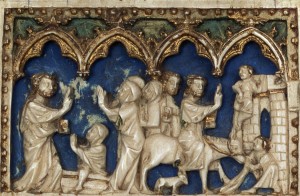
Celebrated seven days before Easter Sunday, Palm Sunday marks the beginning of Passion Week and commemorates Jesus’s triumphal entry into Jerusalem. The episode, which appears in the four canonical gospels, describes the multitudes gathering at the gates of Jerusalem to welcome Jesus, laying their cloaks and branches on the ground in recognition of his status as the Messiah.
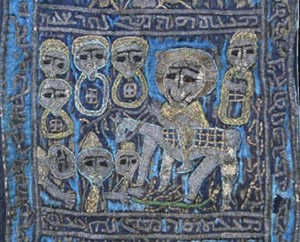
The earliest extant pictorial representations of the Entry into Jerusalem date to the fourth century, and the subject was popular across media throughout the Middle Ages. A highly compressed version of the episode appears on a fourteenth-century ivory diptych from the Abbey of Muri, Switzerland, which is decorated with Passion scenes. The right side of one of the leaves portrays a single disciple trailing the mounted Christ blessing two figures, who serve as shorthand for the multitudes. Equally schematic is the Entry into Jerusalem on the batrashil of bishop Athanasius Abraham Yaghmur of Nebek, produced in Syria in the fourteenth century. This long, embroidered stole shows three figures placing a palm branch before Christ, riding on an ass and attended by five disciples.
The lintel from the main portal of the twelfth-century church of San Leonardo al Frigido in Italy presents a more expansive version of the scene by illustrating all twelve disciples, their open mouths perhaps indicative of speech, and three small figures perched in a tree on the right-hand side of the composition. The last detail, common in depictions of the subject, relates to the prophecy of Zechariah, which describes children breaking branches from an olive tree and following the crowd into Jerusalem.
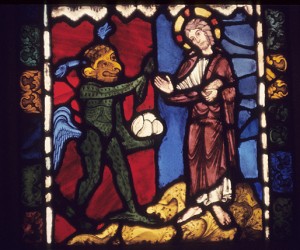
The model during Lent, the forty days of reflection and restraint before Easter, is Christ in the desert overcoming temptation. According to the Gospel writers Matthew, Mark, and Luke, Christ wandered alone in the Judean desert for forty days immediately following his baptism and before starting his public ministry. Satan first tempted Christ in the desert to turn stones into bread. Christ responded by quoting Deuteronomy 8:3, “It is written, man shall not live by bread alone…”. The Gospels describe two other attempts of temptation to win over both Christ’s pride and power. On the second temptation and with a dramatic setting change, Satan tested Christ to act independently from God and use his divine powers to jump from the height of the temple in Jerusalem – Christ firmly refused. Finally, Satan made a grand offer to Christ; to bask in the glory of all the kingdoms of the world if he would give up his mission and be partners with Satan, to which Christ replied, “Get thee hence.”
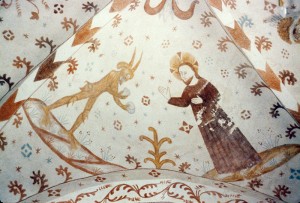
By the time of Gregory the Great, Pope from 590-604 CE, medieval Christians were expected to observe Lent by emulating these desert trials of Christ by fasting from animal products, remaining diligent in prayer, and giving alms to the poor. Typically, one meal per day was consumed during Lent; save the worship day of Sunday, observers were to resist all carnal attractions. The strict prohibitions during Lent required endurance from believers and tested their own degree of devotion.
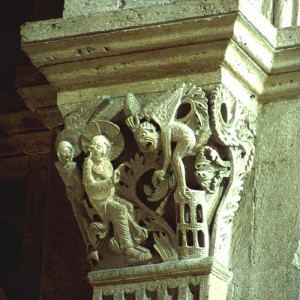
The Index classifies the Temptation episodes in three major divisions according to the number of times the devil tried to seduce Christ. Currently, the database records the most scenes for “Christ: Temptation, 1st,” the temptation for hunger, and works of art are mostly executed in manuscript illumination, but also stained glass, fresco, and sculpture, as shown. There is also a general subject category for “Christ: Temptation” which is used to describe scenes where Christ and Satan are facing each other in an unknown part of the narrative or when all three Temptations are depicted in one scene as in the south vault mosaic at San Marco in Venice . “Christ: in Wilderness” is often a subsequent subject heading applied to the Temptation scenes as well as, “Christ: ministered to by Angels.” The latter records a specific part in the narrative when Christ is kept alive in the desert by angels following the departure of the devil. Lent, coming from the Old English word “lengthening,” is the transitional time in the church calendar and for the seasons.
This year, the vernal equinox in the northern hemisphere falls on Sunday, March 20, marking the moment when the sun shines directly on the equator and the length of day and night are nearly equal. In anticipation of the change of season, The Index of Christian Art presents images thematically related to spring. First, a fifth-century mosaic from the synagogue in Zippori, an abandoned Roman-era town in central Galilee, depicts a personification of spring, identified by Greek and Hebrew inscriptions. Portrayed with roses in her hair, the bust-length figure is flanked by a blossoming branch and a bowl of flowers (on the left) and a basket of flowers and two lilies (on the right).
Second, a personification of March, labelled MARCIUS, graces a Catalonian textile from the late-eleventh or early-twelfth century. The figure appears to be chasing a stork (CICONIA), known as a harbinger of spring because of its migratory patterns. The figure holds a serpent, described in medieval bestiaries as an enemy of the stork, and a frog, perhaps a reference to the rainy season. Above is a personification of the north wind (FRIGUS), as well as a crescent moon and blazing sun. Last, a thirteenth-century Flemish Psalter depicts a figure pruning a stylized tree, an agricultural labor closely associated with the month of March.
As you may know, the Index of Christian Art is in the midst of a major and long-awaited redesign aimed at making our online database more flexible, accessible, and user-friendly. Please help us by taking a very brief (5-10 minutes) survey about your use of the current database. Your responses will help refine the new design with our researchers’ needs in mind. You can access the link here.
All responses will remain anonymous, and all will be valuable in helping us to design a new database that will better serve you and all researchers whose work concerns the history and signification of images in the Middle Ages.
Thank you very much for your support of our work.
Celebrated annually on February 14 as a day for courtship and romance, Valentine’s Day began as a liturgical celebration in honor of one or more Early Christian martyrs named Valentinus. The Roman Martyrology mentions two Valentines, both of whom were decapitated on the ancient Via Flaminia, the main artery connecting the city of Rome to the Adriatic Sea. One Valentine died in Rome and seems to have been a priest. The other, who may have been a bishop, was martyred approximately 60 miles away at Interamna (modern Terni).

The earliest extant connection between Valentine’s Day and romantic love appears in Geoffrey Chaucer’s Parlement of Foules (1383): “For this was on St. Valentine’s Day, when every bird cometh there to choose his mate.” February 14 was associated with courtly love as early as 1400, in a charter ostensibly issued by Charles VI of France (d. 1422). The text describes the festivities of the royal court, which included love poetry competitions, dancing, jousting, and a feast. Contrary to popular belief, there is no firm evidence linking Valentine’s Day with the ancient Roman Lupercalia, a pastoral festival observed from February 13 through 15 to purify the city of Rome and to promote health and fertility.
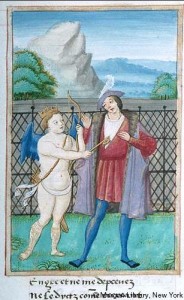
The Index of Christian Art is delighted to present four images thematically associated with Valentine’s Day. First, the nimbed Valentine of Rome is represented with the sword of his martyrdom in the fifteenth-century Hours of Catherine of Cleves (Morgan Library, M.917 and M.945). Second, a sixteenth-century Roman de la Rose contains a charming depiction of the God of Love locking the Lover’s heart with a giant key (Morgan Library, M.948). Third, a fourteenth-century ivory box cover of Parisian origin shows women defending the castle of love, a popular subject in late medieval courtly circles. The winged god of love at the top of the roundel prepares to launch his arrow, while women throw flowers at the attacking knights. Last, a sixteenth-century drawing from an Arma Christi and Prayers (Princeton University Library, Taylor 17), which portrays Christ’s heart with three blossoming flowers, is inscribed pyte, love, and charyte.